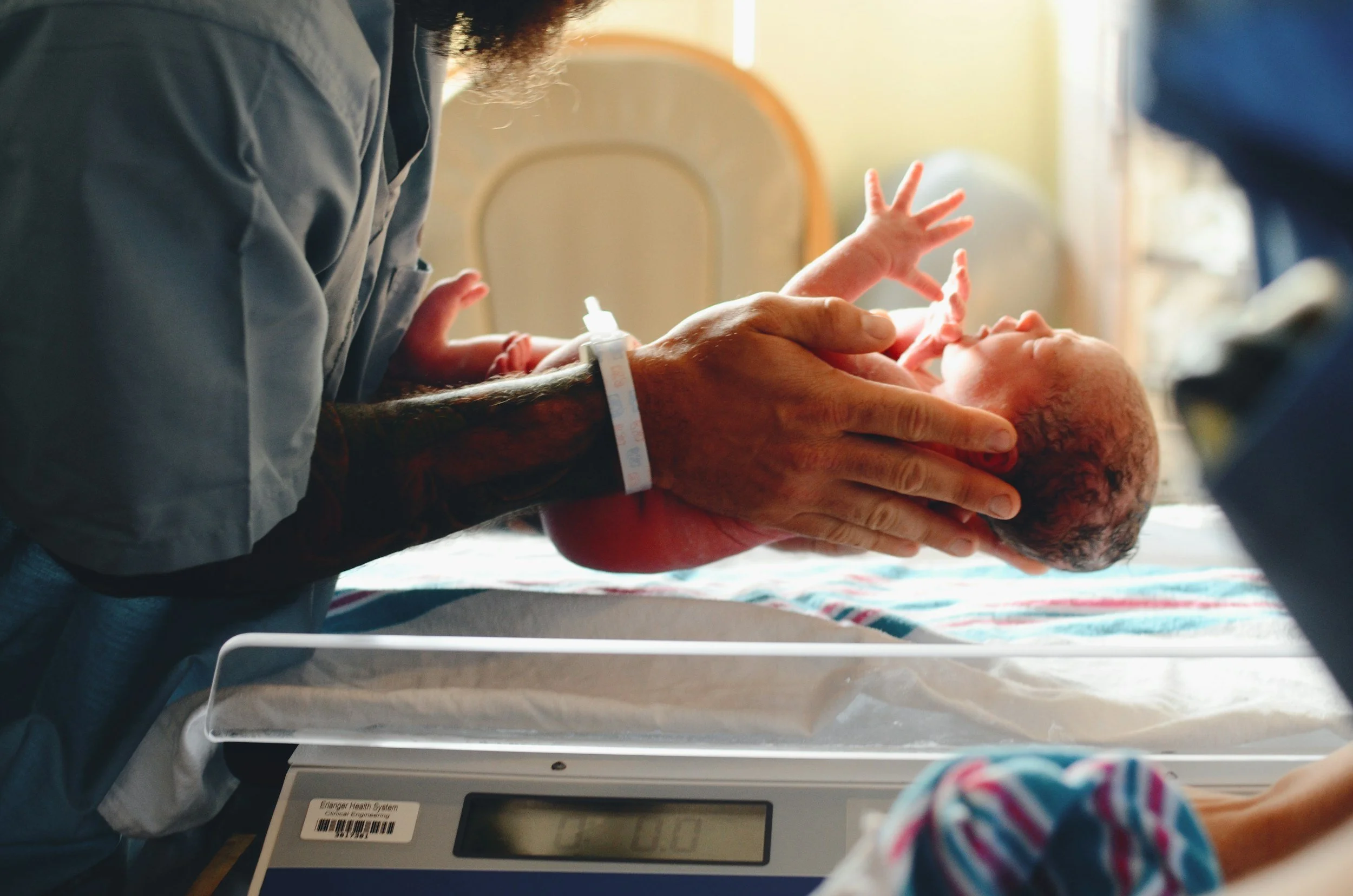Routine & Nursery Care
Welcoming a newborn involves a rapid series of first checks, tests, and sometimes brief nursery stays that can feel overwhelming in the moment. This section explains what happens in those crucial early hours and days – from the initial transition and routine screening to possible nursery admissions and common interventions. Our aim is to demystify each step so you know why it’s done, what’s normal, and when extra support might be needed.
-
The first breath: switching the circulatory gears
Inside the womb, the placenta supplies oxygen whilst blood is diverted away from the baby’s fluid-filled lungs. At birth, a single effective breath clears lung fluid, lowers resistance in the lungs, and floods the air-sacs with oxygen. Connections that bypass the lungs begin to close, sending blood through the lungs instead of around them. Heart rate accelerates to 140–160 bpm, skin perfusion improves, and oxygen saturation climbs steadily over the first 5–10 minutes turning the baby from blue to pink.
Helping physiology along
Most term babies achieve this transition with nothing more than warmth, drying and gentle stimulation. Delayed cord clamping for 60–90 seconds tops up iron stores and provides an extra bolus of blood to fill the newly expanding lungs. Early skin-to-skin contact stabilises temperature, glucose and breathing, while a pre-warmed towel or polyethylene wrap prevents heat loss. During these first minutes we monitor colour, tone, respirations and heart rate – the Apgar score – and, when needed, pulse-oximetry on the right wrist to track oxygenation.
When the lungs need a head-start
Roughly one in ten newborns take longer to inflate their lungs. A neutral-positioned airway, a few mask breaths of room air, and continued tactile stimulation are usually enough to open the air-sacs and establish regular breathing. Positive-pressure ventilation beyond the Golden Minute, chest compressions or medications are required in fewer than 1% of births, but immediate availability of trained staff and equipment ensures these babies receive help before low oxygen or acidosis develops. Once stable, most babies remain with their parents; only those needing closer observation or ongoing respiratory support are admitted briefly to the nursery.
-
Newborn screening: three quick tests with lifelong impact
Before discharge, every baby is offered a hearing screen, blood-spot test, and pulse-oximetry saturation check.
Hearing Test – also known as automated auditory brainstem response (ABR), this test detects mild-to-profound loss that could affect speech and learning; results are available immediately.
Blood-spot (Guthrie) Card – taken at 48–72 h screens for more than 25 rare metabolic, endocrine and genetic conditions. Early detection allows treatment before symptoms appear.
Pulse Oximetry – measured on the right hand and either foot, this screens for critical congenital heart disease and some respiratory disorders; a normal result is ≥ 95% with ≤ 3% hand-foot difference.
Weight & feeding assessment in hospital
Baby weights track early fluid shifts and feeding progress. Up to 10% loss from birthweight is expected in term babies; by day 3–4 weight should stabilise, and most babies regain birthweight by 10–14 days. Midwives record feeds, wet and dirty nappies, and signs of jaundice, guiding any need for lactation support or medical review.
Medical examinations: admission & discharge
A comprehensive head-to-toe check by a neonatologist or paediatrician (or GP in smaller centres) is performed within 24 h of birth. It assesses heart sounds, hips, palate, reflexes, tone and general wellbeing, and documents any birth injuries. A second exam at discharge confirms stability of weight, feeding, colour and vital signs; unresolved concerns prompt follow-up plans or referral.
-
Why Babies Go to the Nursery
Roughly 10–15% of newborns spend time in a Special Care Nursery (SCN) or Neonatal Intensive Care Unit (NICU). Most admissions are brief and precautionary, triggered by one or more of the following:
Prematurity / Low birth-weight – Extra warmth, feeding support and breathing checks while lungs and temperature control mature.
Breathing difficulties (transient tachypnoea, mild respiratory distress) – Short-term oxygen or CPAP to ease work of breathing.
Low blood sugar (hypoglycaemia) – More frequent feeds or IV glucose until levels stabilise.
Significant jaundice – Phototherapy lights to reduce bilirubin.
Infection risk (e.g. maternal GBS, prolonged labour) – Blood tests and IV antibiotics while cultures are pending.
Temperature instability – Humidicrib or warm cot until baby can maintain heat.
Your Role in the Nursery
Admission can feel daunting, but it doesn’t mean you’re separated from your baby. Parents are encouraged to:
Visit freely – most nurseries have open access for parents.
Provide skin-to-skin care (kangaroo care) – as soon as baby is stable.
Offer expressed colostrum or breastmilk – staff can help with expressing and storage.
Ask questions and join rounds – clinicians will update you at least daily.
Learn discharge goals – feeding volumes, weight trends, and observation targets so you know what progress to expect.
Remember, nursery admission is about caution, not failure. It simply gives babies the best start when they need a little extra help.
-
Monitoring & Gentle Support
Every baby in the nursery is placed on cardiorespiratory and oxygen-saturation monitors. Alarms sound for pauses in breathing, low heart rate or falling oxygen, allowing staff to respond before problems escalate. Many babies also rest on warming mattresses or in humidicribs to keep their temperature and skin hydration stable while they grow.
Feeding & Blood-Sugar Management
If a baby is too sleepy or premature to feed effectively, nurses give expressed breast-milk by a gastric tube (a soft tube passed through the nose or mouth to the stomach). Low blood sugar episodes are treated first with more frequent feeds; if levels remain low, a brief intravenous (IV) glucose infusion corrects sugars while feeds are established.
Lights, Lines & Breathing Aids
Phototherapy lights break down excess bilirubin and prevent jaundice complications – usually within 24-48 h.
Peripheral IV lines deliver fluids, antibiotics or glucose when needed; they are removed as soon as baby is stable.
Nasal CPAP or low-flow oxygen may be used for transient breathing difficulties. These non-invasive supports keep the lungs open while fluid clears and energy reserves build; most term babies wean off within one to two days.
Parent Involvement & Going Home
Even with equipment in place, parents can provide skin-to-skin contact, help with tube feeds, and change nappies – activities shown to shorten nursery stays. Discharge criteria include breathing comfortably in room air, maintaining temperature in an open cot, stable blood sugar, effective feeding, and gaining (or at least no longer losing) weight. Most babies meet these goals within 48 h of admission.

